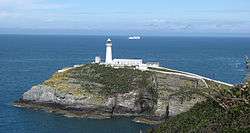Wales
Wales (Welsh: Cymru) is one of the United Kingdom's constituent countries. Wales has a living Celtic culture, with the Welsh language spoken by a fifth of the 3 million inhabitants. The country has scenic mountains and coasts, imposing castles, and much of Britain's industrial heritage.
Regions
Wales is here divided geographically and culturally into three regions:
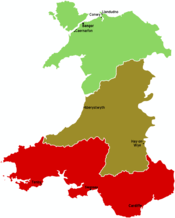
| North Wales (Anglesey, Gwynedd, Conwy and Clwyd) There are several holiday resorts along the coast, but it is primarily a rural and traditional area and has the highest mountains in the United Kingdom south of Scotland. |
| Mid Wales (Ceredigion and Powys) A sparsely populated region of mountains, moorlands, forests, wide river valleys and a coastline facing the Irish Sea. |
| South Wales (Pembrokeshire, Carmarthenshire, Glamorgan and Monmouthshire) The South is by far the most urbanised area. Two-thirds of the population can be found here, especially in the eastern half. The western half, frequently referred to as West Wales, is rural and includes some stunning coastal scenery. |
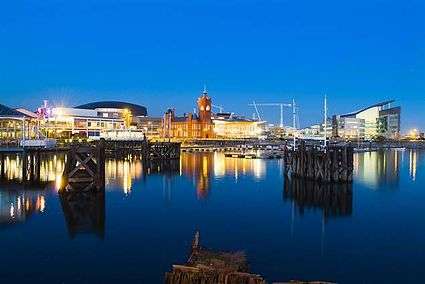
Cities and towns
Wales has many picturesque cities and towns. Those below are amongst the most notable.
Cities
- 🌍 Cardiff (Welsh: Caerdydd) — the largest city and capital of Wales, and a major UK tourism centre.
- 🌍 Bangor — small, picturesque university city.
- 🌍 Swansea (Welsh: Abertawe) — Wales' city by the sea is also the second largest urban area and gateway to the Gower.
The other 3 "cities" in Wales are Newport (granted in 2002) and the two small communities with cathedrals St Asaph and St Davids.
Towns
- 🌍 Aberystwyth — coastal town with large student population.
- 🌍 Caernarfon — site of Caernarfon Castle, one of Wales' largest and best preserved castles.
- 🌍 Conwy — medieval, fortified town with impressive castle and quaint shops.
- 🌍 Hay-on-Wye (Welsh: Y Gelli Gandryll) — the "book capital" of the UK, home to the annual literary festival.
- 🌍 Tenby (Welsh: Dinbych-y-pysgod) — medieval walled town and elegant seaside resort.
- 🌍 Wrexham (Welsh: Wrecsam) — largest town in North Wales.
Other destinations
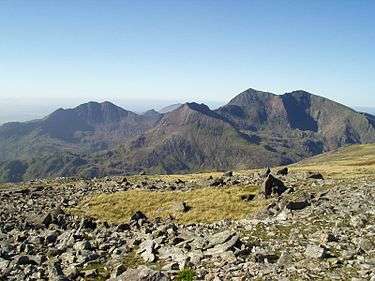
- 🌍 Anglesey (Welsh: Ynys Môn) – large island, home to the town with the UK's longest placename.
- 🌍 Brecon Beacons National Park (Welsh: Bannau Brycheiniog)
- 🌍 Gower Peninsula (Welsh: Penrhyn Gŵyr)
- 🌍 Llŷn (Welsh: Penrhyn Llŷn)
- 🌍 Pembrokeshire Coast National Park (Welsh: Parc Cenedlaethol Arfordir Penfro)
- 🌍 Snowdonia National Park (Welsh: Parc Cenedlaethol Eryri) – popular mountaineering destination
Understand
History
Wales was once an independent, though rarely unified nation, with a strong Celtic and Druidical tradition but when King Edward I defeated Llywelyn the Last in 1282, the nation fell under the jurisdiction of England. At first, it was ruled as a separate country, but rebellion by Prince Owain Glyndŵr (considered in modern times as the 'Father of Welsh nationalism') led to incremental incorporation into England, and Wales was annexed through the Laws in Wales Acts 1535–1542. Since the Acts of Union in 1707, Wales has been part of the United Kingdom which includes England, Northern Ireland, and Scotland too.
Prior to the industrial revolution, Wales was a sparsely populated country dependent on local agricultural and pastoral trade. However, due to the abundance of coal in the South Wales valleys, there was a phenomenal growth in population and a dynamic shift in the economy of South Wales during the 18th and 19th centuries (see Industrial Britain). The area of central Glamorgan, in particular, became a national focus for coal mining and steel production, while the ports of Cardiff and Swansea established themselves as commercial centres, offering banking, shopping and insurance facilities. Moreover, places on the north coast, such as Rhyl and Llandudno, developed into fun-fair type resorts serving the expanding populations of the major industrial cities of Lancashire.
Coal mining has all but ceased and heavy industry declined. However, Wales' attractive scenery and rich history has lent itself to the development of tourism, while at the same time, Cardiff and Swansea have retained their rankings as centres of commerce and cutting-edge industry. Cardiff, which was designated as capital of Wales in 1955, has seen a huge amount of investment in institutions through 'devolution', also giving rise to a significant amount of political power being passed down from Westminster. Since 1999, Wales has had its own legislature separate from Westminster, known as the National Assembly for Wales, with the First Minister being the leader of the Welsh government.
Politics
Wales is governed by a combination of local, Wales-, UK- and Europe-wide institutions. Many important matters are decided on a UK and European Union level. Welsh representatives sit in the British and European Parliaments.
There has over time been a move to devolve certain powers of decision to a Welsh level, starting in 1906 with the establishment of a "Wales and Monmouthshire" Education Board. One of the greatest British statesmen of the 20th century was the Welshman David Lloyd George, who is the only Prime Minister whose first language was not English (it was Welsh). The year 1964 saw the creation of the non-elected Welsh Office headed by a Secretary of State for Wales, sitting in the UK Cabinet. Following a referendum in 1997, the Welsh Office was replaced by an National Assembly for Wales based in Cardiff Bay in 1999. It had minor law making powers and an executive (including a First Minister). In 2006 the Assembly moved into a new purpose-built building known as the 'Senedd', which has won awards for its environmental design by Richard Rogers. In 2011, following a further referendum, the Assembly obtained further law-making powers, and its structure was reformed so that there was a clearer separation of powers between the Assembly and the Welsh Government. Many decisions on tourism, transport and healthcare are taken by the Welsh, rather than the United Kingdom Government. Sometimes these lead to visible differences from the rest of the UK: for instance, National Health Service prescriptions are dispensed free in Wales.
Wales has long been generally more left-wing in its politics than the UK as a whole. Since devolution in 1999, the Labour Party has continuously formed the government, in coalition with the centrist Liberal Democrats from 2000 to 2003, and with the Welsh nationalist party Plaid Cymru from 2007 to 2011. Support for devolved government has increased markedly (in the 1997 devolution referendum the "Yes" majority was less than 1%; in the 2011 referendum on enhanced powers for the Assembly the result was almost 2 to 1 in favour), but support for full independence is limited and certainly lower than in Scotland.
Culture
Wales is part of Britain and so part of the UK, but is not part of England. It is correct to call Welsh people British, but incorrect and even offensive to call them English. Over the centuries, there have been minor revolts aimed at gaining independence, but in general Wales has accepted its place in the UK, and has made notable contributions to its politics and culture. Nevertheless, Wales has remained a bastion of Celtic culture, and the Welsh language continues to be a topic of pride and is widely spoken, especially in rural areas. It is now taught in all Welsh schools.
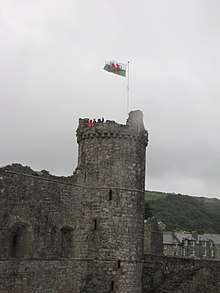
The Prince of Wales (currently HRH Charles) has been since Edward the I's day the eldest son of the sitting monarch, and is therefore usually the next in line to the British throne. It is for this reason that Wales is often referred to as a principality, even though the Prince has no constitutional status in Wales, and doesn't even reside in the country.
The Prince of Wales' heraldic badge of feathers is sometimes used to symbolise Wales, though the daffodil flower, the leek and, above all, the red dragon tend to be more popular symbols. The origins of the leek can be traced to the 16th century, while the daffodil became popular in the 19th century, encouraged by David Lloyd-George. Both the leek and daffodil are commonly worn on the lapels of people celebrating St David's Day, which is Wales's national day and a public holiday, celebrating the country's patron saint. Dragons have been associated with Wales since the early Middle Ages, and the red dragon (y ddraig goch) in particular has been used as a symbol of Wales throughout the centuries, and is now featured on the country's flag.
Rugby union is hugely popular in Wales and is considered the national sport. Attending a Wales international game in a packed-out Principality Stadium in Cardiff is a most electrifying experience, and a great opportunity to hear the country's national anthem, Hen Wlad Fy Nhadau (The Land Of My Fathers), belted out by 50,000 or more Welsh fans.
Indeed, the country is celebrated for its singing, with the ballads Calon Lân, Cwm Rhondda (Bread of Heaven) and Men of Harlech fundamental parts of the repertoire of any respectable Welsh choir. The country's long tradition of folk music and literature is celebrated annually at the National Eisteddfod, while famous musicians in the contemporary era include Sir Tom Jones and Dame Shirley Bassey, and the rock bands, Stereophonics, Bullet for my Valentine, and Manic Street Preachers.
Other famous Welsh people include Henry VII (the first of the Tudors, the famous dynasty of 15th and 16th century monarchs); Anthony Hopkins, Catherine Zeta-Jones and Christian Bale (Hollywood actors); Aneurin Bevan (politician, father of the National Health Service), Ryan Giggs (former footballer and now coach), Gareth Bale (current footballer), Bertrand Russell (philosopher), Dylan Thomas (poet and author) and Richard Burton (poet and actor, linked to Thomas forever by Under Milk Wood).
Climate
If it is not raining at the moment, it is certainly about to rain. This does, however, produce an intensely green and beautiful landscape. Summer average temperature is around 20 °C (68 °F) while spring and autumn is about 14 °C (57 °F). The weather varies substantially depending on the location and landscape, the coastal area being much milder than in the mountains.
Talk
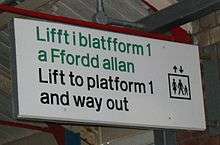
English is spoken throughout the country, but Wales also has its own language, Welsh (Cymraeg). This is a Celtic language whose cousins include Irish and (more closely) Breton, and is very different to English. You will rarely hear it spoken in the southeast, but in the north or west, you will often overhear conversations between locals in Welsh, though residents will quickly switch to English to converse with visitors.
The most direct contact you will have with the Welsh language may be with signs, which are written in Welsh and English, and with Welsh place-names, and even locals who are not fluent in Welsh usually know how to pronounce Welsh words. It is well worth brushing up on the rules for pronouncing Welsh words; otherwise you will almost certainly pronounce many Welsh place-names incorrectly. Some English placenames are derived from Welsh (like Caerdydd/Cardiff or Aberdâr/Aberdare) but others are completely different (like Abertawe/Swansea or Casnewydd/Newport). On road signs there is no colour coding to distinguish the languages, nor is there a standard protocol as to which language appears on top, although generally the Welsh name will appear first in majority Welsh-speaking areas, and the English name will appear first in majority non-Welsh-speaking areas. Where the English and Welsh names for a town are the same (like Aberystwyth, Bangor or Llanelli), only one name will appear.
There are several regional accents of English spoken in Wales. That spoken in the South Wales Valleys and further west is perhaps closest to the "stereotypical" Welsh accent, while in the North, where the greatest number of native Welsh speakers live, the accent is noticeably distinct and more nasal, blending in north-east Wales to something similar to Scouse (the accent and dialect of Liverpool). Cardiff has a distinct accent all of its own - the name is sometimes jokingly spelt 'Kairdiff' as an indication of this. However, no Welsh accent should present much difficulty to anyone with a decent command of English. There are a few parochial colloquialisms that may take you a moment to work out what is meant, but don't be worried to ask for someone to repeat something. 'Aye', is commonly used to indicate 'yes' and 'ta-ra' can be said instead of 'goodbye'. 'Tidy' is often used but has a wide meaning ranging from fine/splendid or large (quantity), as in 'a tidy amount'. 'Butty' (which in north England would be a sandwich) is sometimes used for friend/buddy.
Most Welsh people will react well when interest is shown in their language. Although Welsh is now taught in schools and most younger people have some knowledge of the language, this developed in the late 20th century. For decades before that the use of Welsh at home and in the community was officially discouraged. Local television channel S4C broadcasts entirely in Welsh, while the BBC also runs news broadcasts and other radio programmes in Welsh on Radio Cymru.
Locals will rarely expect visitors to attempt to speak Welsh. Using words like bore da (good morning), iechyd da (cheers) and diolch (thank-you) will be greatly appreciated in some parts of the country; and even non-Welsh-speakers are usually supportive and welcoming if you try a few words.
Get in
Wales has the same immigration and visa requirements as the rest of the UK. Almost all passengers travelling to the UK from outside Ireland, the Channel Islands and the Isle of Man go through systematic passport/identity card and selective customs checks carried out by the UK Border Agency on arrival in the UK.
- EU, EEA and Swiss citizens do not require a visa, and can enter with either a valid national identity card or passport. They have the right to reside and work in Wales. Irish, Cypriot and Maltese citizens have additional rights, including being able to vote in and stand in UK Parliamentary elections. For more information about UK Immigration and visa requirements, see the UK's Home Office website.
There is no internal border control between Wales and England. Two major routes, the two Severn Bridges crossing the Bristol Channel, charge a toll (£6.40 for a car) going into (but not out of) Wales, leading some people to describe it as a "tax on entering Wales". After years of accepting only cash, the bridge authorities now accept major credit and debit cards too, although this seems to have meant the end of the facility to pay the toll in euros (€). The road and train networks are fully integrated between England and Wales, meaning travel between the two nations should be stress-free. The M4 motorway runs from London and is the main artery into South Wales and it can get congested at peak hours.
By plane
Cardiff Airport (CWL IATA) is the only international airport in Wales. It is 9 mi (14 km) west of the city, near Rhoose. The airport is a major hub of flybe and Thomas Cook, which have a few long-haul flights, such as Barbados. Anglesey Airport (VLY IATA) is the only other commercial airport in Wales, with weekday services to and from Cardiff.
- Eastern Airways operate flights to Aberdeen and Newcastle.
- Flybe operate multiple daily services to George Best Belfast City Airport, Newcastle Airport, Edinburgh Airport, Jersey, Glasgow Airport, Dublin and Paris Charles de Gaulle Airport. Seasonally to Düsseldorf
- KLM operates services to Amsterdam 4 to 5 times a day.
There are also many seasonal flights catering to packaged holidays with companies such as Cosmos Holidays, Thomas Cook, Ryanair and TUI Airways flying to many destinations in Greece, Spain and North Africa.
There are regular bus services from Cardiff city centre to the airport. You can also get to the airport using a bus service from Barry Station, which is closer to the airport and on local rail lines. A nearby railway line has a station at Rhoose, where there are shuttle buses to the airport.
Bristol Airport is also gaining popularity, and there are dedicated coach services between Bristol Airport and central Cardiff.
Birmingham Airport is well served by long-haul destinations and is in easy driving distance to Wales. Liverpool John Lennon Airport is smaller, having flights mainly to continental Europe, but is in striking distance of North Wales.
It could be easier to fly to an airport in England such as one of the London airports when visiting South Wales, as a greater range of airlines and cities flown from are available from there to destinations around the world, with services from many airlines. However London is over 2 hours from Cardiff, and longer from many other places in Wales. If you do choose to fly into London, then Heathrow Airport is much closest to Wales in terms of travel time (around 2 hours to Cardiff, subject to traffic); Gatwick, Luton and Stansted airports are around an hour further away. Other cities served by international airports in England which offer reasonable access to parts of Wales include Birmingham (BHX IATA) for mid Wales, Liverpool (LPL IATA) and Manchester (MAN IATA) for north Wales.
By car

South Wales enjoys good motorway connections with the rest of the UK:
- The M4 links London with Bristol, and via the Severn Bridge, Newport, Cardiff, Swansea, and Carmarthen.
- The M50 links the West Midlands with Monmouth, the Brecon Beacons and all of south and west Wales. Before tolls were removed from the Severn Crossing in December 2018, this was also a popular route for travellers from the English Midlands or further north who wished to avoid the Severn tolls.
North Wales has no motorway connections. However there are still good road connections with the rest of the UK:
- The A5, followed by the M54 after Shrewsbury, to London and the West Midlands takes you through the spectacular Snowdonia National Park
- The A55 (which is of motorway standard for most of its length) runs along the entire north coast from the English motorway network near Chester to the island of Anglesey. It is much quicker than the A5 although also much less scenic.
Mid Wales only has single carriageway roads:
- The A456 Shrewsbury to Welshpool being the main route
- The A44 from Worcester can be a slow route
There are no internal border controls within Great Britain and you may not notice the border if entering Wales from England via a minor road. You will usually see the Croeso i Gymru ("Welcome to Wales") sign crossing the border.
By train
- See also Rail travel in the UK

Railway companies include Arriva Trains Wales, Virgin Trains, London Midland and First Great Western.
South Wales
Main line rail services connect south Wales (especially Newport, Cardiff and Swansea) with all parts of the UK, via Virgin Trains [(to Birmingham and the North East, including Scotland), London Midland (to Birmingham and the Midlands), Arriva Trains Wales and First Great Western (to London Paddington).
North Wales
- The North Wales Coast Line links Manchester, Crewe and London (in England) with the northern seaside resorts of Rhyl and Prestatyn, the city of Bangor, the isle of Anglesey and the port of Holyhead. Through tickets to Dublin (Ireland) are available, which include the ferry from Holyhead to Dublin Port. Services are run by Arriva (from Manchester) and Virgin Trains (from London and Crewe) is
- The Conwy Valley Line stretches from Llandudno Junction along the Conwy Valley via Betws y Coed to Blaenau Ffestiniog, and connects with trains on both the North Wales Coast line and the Ffestiniog Railway.
- The beautiful Cambrian Coast Line runs from Shrewsbury (in England), across Mid-Wales through Machynlleth, and through the coastal towns of Tywyn and Barmouth, through the south part of Snowdonia, Harlech and Porthmadog, and along the south coast of the Lleyn Peninsula to Pwllheli.
- The Borderlands Line runs between Shrewsbury, Wrexham and Bidston, linking various Flintshire towns and villages with the Wirral, Shrewsbury and Wrexham. Wrexham and Shropshire Railways services link Wrexham, Oswestry and Shrewsbury to London Marylebone station.
Mid Wales
Mid Wales is very sparsely populated and does not have extensive rail services. Nevertheless a few routes exist that show the beauty of the country:
- Arriva Trains also run the famous Heart of Wales Line from Swansea to Shrewsbury. As the name suggests, this service runs through very scenic area in the middle of the country. The train takes almost 4 hours to make the 120 mi (190 km) journey due to the many gradients and turns. It is popular with tourists but also provides an essential service to rural communities along the route.
- The Cambrian Line takes the same route as the Cambrian Coast Line as far as Machynlleth, where it goes southwards along the coast through Borth to the university town of Aberystwyth.
By coach
.jpg)
National Express operates coach services around the UK including to and from many parts of Wales. There are direct National Express coaches from London Heathrow Airport that go directly to Cardiff and Swansea.
By boat
- See also: Ferry routes to British Mainland
It's possible to take several ferry routes from Ireland to Wales, the main routes are Holyhead (which is on Holy Island, linked to the island of Anglesey by a causeway, and Anglesey is linked by bridge to mainland Wales) and Fishguard on the south-west coast. These tend to be the cheapest and fastest, if you hunt around between the different ferry companies. Stenaline and Irish Ferries offer multiple daily services for passengers and vehicles. Bookings can be made through their websites. Stena operate the route to Fishguard, Irish Ferries operate the route to Pembroke Dock, and both operate to Holyhead.
Get around

General
Due to Wales' topography and historic development, most travelling in Wales is done east-west rather than north-south. Rail and road links between centres in South Wales and along the North Wales coast are usually quick and efficient, especially along the M4 and A55. An important exception to this is M4, J32 (the interchange with the A470), during peak morning rush hour, which gets congested with Cardiff commuter traffic. The roundabout at J32 is the largest in Europe. Most places in South Wales are within a 90-min drive of each other.
Travelling between Cardiff and the other main population centres, Swansea and Newport, is very straightforward.
Although only approximately 170 mi (270 km) from coast to coast, the topography makes north-south links more difficult in terms of time. By land, journey times are comparable to flight times across North America! However, the journey itself is something a visitor may wish to do to see the scenery.
- Traveline Cymru - bus, coach and rail journey planning and timetable information
By plane
Wales is a small country and flying is not a common mode of internal transport. There is in fact only one domestic route, Cardiff International Airport to Anglesey Airport. This is probably the quickest way by far to travel between North and South Wales.
This route is served by two services each way per day. The journey costs approximately £50 each way and takes about an hour. This option is most useful for those travelling between North West and South East Wales. The service is provided by the airline City Wing.
By car
Wikivoyage has a guide to Driving in the UK, including within Wales.

It is much easier to drive from east to west across Wales (via the M4 or A55, for instance) than from north to south, due to the mountainous terrain of much of the interior. Those who know the route well can drive from North to South Wales in under 4 hours; those who do not should allow 5 or 6 hours. But that is time well spent: the journey takes in some spectacular scenery, especially for journeys on the more Western route through Snowdonia via Corris, Dolgellau, Blaenau Ffestiniog, the Crimea Pass and the Conwy Valley. The two main North South roads are the A470 Cardiff to Llandudno and the A483 Swansea to Chester. However, neither is a fast road: the A470, for instance, has only a 25-mile (40-km) two-lane stretch (from Cardiff to Merthyr Tydfil); while much of the rest of the route has been improved, there are still many places where the road is narrow and winding, and where trucks or agricultural vehicles can slow traffic considerably.
Roads are generally well-maintained and signposted, although flooding is a risk after heavy rain - particularly in the wetter west and north - and the higher mountain passes can become icy and treacherous in winter. Also beware of livestock on the roads: sheep (of which there are more than four times as many in Wales as people) will often graze on roadside verges, including alongside main roads in rural areas, and can stray on to the carriageway seemingly oblivious to passing traffic. It is also quite common for farmers to have to herd sheep or cattle along or across a road from one field to another. If you come across this, remember that the farmer is just doing his or her job, and be patient: sounding your horn or revving your engine will only alarm the livestock (and annoy the farmer), causing even greater delays.
By train
Wikivoyage has a guide to Rail travel in the United Kingdom, including within Wales.
Due to various closures in the 1960s there is no true "Welsh railway system". Basically there are three separate Welsh limbs which are part of the British system although there have been moves to improve intra-Wales railway services. The limbs are a North Wales line to Holyhead, a line to Aberystwyth in the centre, and a main line in South Wales, forming an extension of the London Paddington to West of England main line.
Arriva Trains Wales provides most train services within Wales.
Two cross-border train companies may also be of use for internal train journeys within Wales. First Great Western provide the bulk of cross border services between England and South Wales. Their flagship High Speed Service generally goes as far west as Swansea, and there are even a limited number to destinations further West. Their "local" services to Bristol Temple Meads and the South West of England go no further west than Cardiff. Arriva Trains Cross Country provide services as far west as Cardiff to Birmingham and onwards to Nottingham.
Regular train services connect the South Wales' three main cities, Cardiff, Swansea and Newport. Services between Cardiff and Swansea are usually every 20 minutes, and even more frequent between Cardiff and Newport.
Cardiff is also the hub of the Valley Line network which serves a number of former coal mining towns. This railway system was built to carry coal; it is now mainly a commuter network and is useful to visitors to the Valleys, or indeed for local travel within Cardiff.
Swansea and Llanelli in the West are linked to Mid Wales via the Heart of Wales railway, whilst not a quick journey it is well worth considering for its scenery.
Rail connections between North and South Wales in fact cross into neighbouring England, although there are a number of direct services between Cardiff and North Wales along the Marches line via several places in England. There are two high speed services each day between Holyhead and Cardiff, which only stop at a limited number of stations in England.
- Arriva Trains Wales operates most local rail services in Wales
- First Great Western operates cross border services between South Wales and London, Bristol and the rest of South West England.
- Virgin Trains operates services between North Wales, Birmingham and onwards to London.
- Crosscountry operates an hourly service between Nottingham and Cardiff, going through Birmingham.
By bus and coach
The First Cymru Shuttle coach service is usually quicker than the train for journeys between Swansea and Cardiff, but at peak times, the train does not get stuck in traffic!
.jpg)
Government-funded Traws Cambria services connect North, Mid and South Wales.
- Arriva operates a large amount of bus services in North Wales
- First Cymru operates services in South West Wales
- Stagecoach operates services in South Wales
- Cardiff Bus operates services in Cardiff
- Veolia Transport Cymru operates services in Cardiff and South Wales
Traveline Cymru has a search facility for all Welsh public transport routes.
See

Wales has many significant attractions, and listed below are a few of the most notable. For more details about these attractions plus information on other places of interest, check under regional sections.
Much of Wales' scenery is spectacular, and environmentally important. To protect the environment certain parts of Wales have been designated as "National Parks" or as "Areas of Outstanding Natural Beauty". An area with either of these designation will have a high degree of protection from inappropriate development. Whilst these rules exist for environmental reasons, rather than to promote tourism, because "National Parks" and "Areas of Outstanding Natural Beauty" have this protection, a visitor to these areas can be confident that they will see some unspoiled scenery. These areas offer some of Wales' most attractive scenery, and a visitor would be well advised to visit at least one of these areas. That is not to say that there aren't other attractive places in Wales, but the "National Parks" and "Areas of Outstanding Natural Beauty" are the "jewels in the outdoor crown".

Wales has three National Parks: Brecon Beacons National Park (Mid Wales), spectacular mountain scenery and castles, pretty highlands turned into a national park with weaving streams, waterfalls and canals; Pembrokeshire Coast National Park (South Wales) with dramatic coastal scenery; and Snowdonia National Park (North Wales) covering Wales' highest mountains, and considered by some to be the most beautiful and poetic in Britain.
National Park status offers the highest level of environmental and planning protection in Wales. National Parks tend to cover some very large areas. It should therefore come as no surprise, that some of Wales' most important scenery can be found within its National Parks. Each "National Park" is administered by a special-purpose local authority, called a "National Park Authority". These organisations primarily exist to ensure that laws protecting the environment and scenery are followed. Nevertheless a National Park Authority will organise and run various facilities in the area which are clearly "branded" as official facilities. These facilities will include public toilets, car parks, visitor centres, and even gift shops selling branded merchandise. However the National Park Authority does not own most of the land in these areas, and so there is private and charitable provision of facilities such as car parking, and retail outlets too. It is also usual that the boundaries of a national park are marked on the ground where roads enter them, so you will often know when you have entered a National Park, for example there may be a stone or a sign stating you are entering the area. The websites of the relevant National Park Authorities will often have a section designed particularly for visitors and may well be very useful to someone planning a trip to the area, even containing information such as accommodation information.
Other important areas which do not have National Park status, have the alternative status of Area of Outstanding Natural Beauty (AONB). These areas tend to cover smaller areas than "National Parks", they will nevertheless be of interest to visitors. AONBs are not run by government but are simply areas with a similar level of protection to National Parks, but remaining under the jurisdiction of the relevant local authority. Like the National Park Authorities, local authorities with "AONBs" in their area do generally take their duties seriously to enforce planning laws, but unlike them, may not organise any "AONB" branded facilities in these areas. So there don't tend to be official branded facilities such as visitor centres, car parks, and gift shops. These facilities may exist but by conventional private, charitable and municipal provision. The actual boundaries of AONBs - whilst they are often shown on the rear covers of "Ordnance Survey" maps, tend to be of importance to local government officials and landowners, rather than tourists. It is therefore not usual to see markers or signs at the boundaries of these areas on the ground. The official websites of "Areas of Outstanding Natural Beauty" are usually part of a local authority's main website. They may still have useful information, but do not expect the same level of specialisation as on a National Park website.
The Isle of Anglesey AONB is predominantly coastal, covering most of the island's 125-mile coastline. Gower Peninsula (Swansea), UK's first designated area of outstanding natural beauty, covers most of the peninsula. Lleyn AONB, the peninsula sticking out westwards beyond Snowdonia, in the north-west of the country. Clwydian Range and Dee Valley AONB is a range of hills running southwards from the coast at Prestatyn, Denbighshire in the north-east of the country, close to the border with England, now extended to include the spectacular hills around the river Dee near Llangollen. The Wye Valley AONB straddles the southern end of the England/Wales border between Hereford and Chepstow

A number of UNESCO World Heritage sites can be visited, including the Blaenavon Industrial Landscape, the Pontcysyllte Aqueduct - near Chirk and of course the North Wales Castles built in the decades after the invasion or conquest of Wales by England in the 13th century, representing the most advanced military technology of the time, being compared with the Crusader Castles of the Middle East. Castles of note being Caernarfon, Conwy and Harlech.
Key listed historic building worth visiting include Caerphilly castle, the second largest in the UK, Pembroke castle, Raglan castle, the ruins of Tintern abbey and the incredibly preserved and restored Elizabethan house Plas Mawr in Conwy.
There is a good selection of national museums and galleries to visit. These are: The National Museum (collection of paintings, archaeological finds and geological exhibits ), Cardiff; St Fagans National History Museum (many historic buildings, relocated from their original site), near Cardiff; The National Slate Museum, Llanberis; Big Pit (The National Coal Museum),Blaenafon; The National Woollen Museum, Dre-fach Felindre, near Llandysul; The National Roman Legionary Museum, Caerleon, Newport; The National Waterfront Museum (maritime and industrial past), Swansea. Entry to national museums are free, although expect a charge for car parking.
There are also many stately homes, gardens and estate parks to visit. One of the most visited being the National Botanic Garden of Wales near Carmarthen.
Do
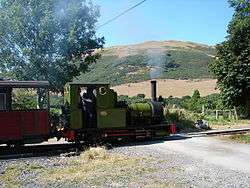
Heritage railways are more generally thought of as pleasurable attractions rather than ways to get around, although the Ffestiniog Railway, initially depended on gravity and horse power, from Porthmadog to Blaenau Ffestiniog can be used to link places on main rail lines, and the opening of the Welsh Highland Railway has created a useful link between Caernarfon, Beddgelert and Porthmadog. The Vale of Rheidol Railway provides a novel way from Aberystwyth to Devil's Bridge. They are all historic lines that have been either preserved or restored with steam a major feature on these lines. Others include Bala Lake Railway, Brecon Mountain Railway, Gwili Railway, Llanberis Lake Railway, Welshpool and Llanfair Railway, Talyllyn Railway the World's first heritage railway, and perhaps the best known of all the Snowdon Mountain Railway.
Wales' offers some spectacular coastal and mountainous scenery. Which offers the opportunity for various activity holidays.
Walking in Wales, either small hikes or the long distance paths such as the Wales Coast Path following the entire coastline of Wales or Offa's Dyke Path near the border of Wales and England. For the more experienced Snowdon is the highest mountain in Wales and offers ideal hiking opportunities and Pen y Fan, is the highest mountain in South Wales, situated in the Brecon Beacons is 886 m (2,907 ft) high. Cadair Idris, close to the Mid-Wales coast, overlooking Dolgellau to the north and Bro Dysynni to the south-west is another very popular mountain. It has good rail access on both North and South sides from the Cambrian Coast Line, but this is virtually at sea level. The actual summit is 893 m (2,930 ft) above sea level. This makes for a strenuous walk which takes most of the day.
Wales has a long golfing history, with many top-quality courses, however it offers golf courses which tend to be less crowded, and less expensive than the other Western European destinations. As a very rough rule North Wales tends to have the better links courses, and the South the better parkland courses, although it is well worth playing both sorts of courses in both parts of Wales just to find out! There is a relatively high density of courses in the Vale of Glamorgan, between Cardiff and Bridgend, due to the proliferation of courses in the last fifteen years serving the Cardiff Commuter Belt. There is also a high density of courses in the Conwy and Llandudno area. Further details can be obtained from the Welsh Assembly Government's official golf tourism website, and on pages concerning the specific areas of Wales. Wales' most prestigious courses include: The Celtic Manor Resort in Newport, Monmouthshire, it has three courses, and is the venue for the 2010 Ryder Cup; Conwy (Caernarvonshire), Conwy, Caernarvonshire - this Links hosted a final qualifying round for the 2006 Open Championship; Machynys Golf and Country Club, Llanelli, Carmarthenshire - Links, opened in 2005 Wales' first and so far only Nicklaus-designed course.
Scuba diving, exploration beneath its surrounding seas, is an activity not many tourists think of when visiting Wales. Although weather conditions are not always perfect, water temperatures are quite chilly, scuba diving in Wales is one of the best experiences for divers around Europe. You can find whales, dolphins, plenty of seals but also superb coral formations including seahorses and several coral fish. The Isle of Anglesey has been encircled by shipping routes for centuries resulting in striking shipwrecks of all sizes. Pembrokeshire with its scenic islands Skomer Island, Skokholm Island and the isolated rocks called the Smalls are known for their colonies of seals and many shipwrecks.
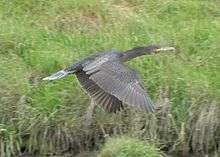
Wales is a great destination for Birdwatching, the long coastline provides excellent habitats for seabirds while the hinterland is home to many birds of prey. Notable destinations are Bwlch Nant yr Arian Forest Visitor Centre for red kites, Cors Dyfi Reserve for Osprey, while for seabird must visits are the South Stack Cliffs RSPB reserve and the Conwy RSPB reserve.
While in the country you should take the chance to experience the agricultural scene, whether the large Royal Welsh agricultural show or a small town sheep auction or a sheep dog trail.
Music
- See also: Music in Britain and Ireland
Wales is often referred to as "the land of song", and is notable for its harpists, male voice choirs, and plethora of solo artists like Charlotte Church. Cardiff has a big rock scene and has produced some of the biggest acts in the UK today. The Welsh Folk Song Society has published a number of collections of songs and tunes. Check the web sites of local male voice choirs for dates of concerts.
The principal Welsh festival of music and poetry is the annual 🌍 National Eisteddfod (Eisteddfod Genedlaethol Cymru). Taking place in the first week of August, a Welsh-language week-long event with simultaneous translation available for the main events that is hosted by a different town each year, alternating between north and south Wales. Its history can be traced back to 1176, and its modern incarnation had been running since 1861. In August 2018 it will be in Cardiff.
The Llangollen International Eisteddfod echoes the National Eisteddfod but provides an opportunity for the singers and musicians of the world to perform. Traditional music and dance in Wales is supported by a myriad of societies.
Notable musical events include the Cardiff Singer of the World Competition, the Brecon Jazz Festival (August) and the Swansea Festival of Music and the Arts an annual (October) three-week bash of culture at various locations in Swansea, and the second largest such festival in the UK.
Others of note include the Faenol Festival organised by the internationally renowned opera singer Bryn Terfel, (August Bank Holiday weekend every year at Y Felinheli) and Sesiwn Fawr a World Music Festival which takes place every July in Dolgellau.
Literary events

The famous Hay Festival literary festival, which Bill Clinton aptly described as 'The Woodstock for the Mind.' takes place end of May begging of June.
The Dylan Thomas Festival in Swansea is an annual event held between 27 October and 9 November (the dates of the poet's birth and death) to commemorate the works of Thomas. In addition, the festival hosts the awards' ceremony for the winner of the Dylan Thomas Prize - a biannual writing competition for most outstanding literary talent in English, aged under 30. Complimenting the main events at the Dylan Thomas Festival the Dylan Thomas Fringe is held at various venues throughout the city.
Sporting events
Six Nations Rugby Tournament - Cardiff's Millennium Stadium hosts two or three matches per year as part of the premier Northern Hemisphere Rugby Tournament. Cardiff will host many visitors attending the game. Tickets and accommodation would generally need to be bought well in advance. If you are able to see a match then it is a valuable insight into Welsh culture, whether watching in a pub or in the Millennium Stadium.
Football (soccer) is also popular in Wales, though attendances in the local Welsh league are low, and the two biggest Welsh clubs, Cardiff City and Swansea City, both play in the English league system. The top Welsh players also tend to play for English rather than Welsh clubs. That said, the Welsh national team enjoys strong support, having featured world-class players such as Ryan Giggs and Gareth Bale, and play their home games in Cardiff's Millennium Stadium.
The Wales Rally GB: 4–7 October 2018. Usually the final round of the FIA World Rally Championship, it takes place at near the end of each year in many locations around Wales. (date needs updating)
Buy
Like the rest of the United Kingdom, Wales uses the pound sterling (£). Unlike Scotland and Northern Ireland, there are no separate banknotes in Wales, only those issued by the Bank of England. Indeed, Scottish and Northern Ireland banknotes may not be easy to spend, although they can be exchanged at any bank. Most banks and travel agents will also change foreign currency, although it is worth shopping around for the best rates.
ATMs are widespread, even in small towns: they can be found in many post offices, convenience stores and petrol stations as well as in banks. However, many banks in small towns have closed, and ATMs in other locations often charge you (maybe £1-£2) for withdrawing cash.
As in the rest of the UK, beware of ATM fraud, which is becoming increasingly common. The fraud works either by 'skimming' your card (reading the details on it with a device attached to the ATM) or trapping it in the machine, and using a hidden camera to record your PIN as you enter it. Never use an ATM with a card slot which appears to have been tampered with, and always cover the key pad with your hand, wallet or purse when entering your PIN. If you find an ATM which seems to have been tampered with, or if it retains your card, report this at once to the bank which owns it and to the police.
Costs
Costs are broadly comparable with the rest of the UK; hotels, bars and restaurants in Cardiff are relatively expensive, while the rest of the country is perhaps slightly cheaper. Petrol and diesel is often much more expensive in rural Wales than in the main towns and cities.
Eat
See also: Welsh cheese

Wales is associated with many particular dishes, and there are a number of unique foods that you might like to try. The quality of local ingredients is often very high, with a drive towards locally sourced, organic produce in many restaurants.
- Roast lamb. Wales is noted for the high quality of its lamb, due to the luscious green grass they graze on. Often served with mint sauce and vegetables.
- Cawl (Lobscouse). A lamb broth.
- Bara brith. A rich, sweet bread loaf speckled with dried fruit, similar to a fruitcake.
- Welsh rarebit (original spelling Welsh rabbit). A melted cheese and mustard dish, often spiced with onions, ale and herbs and served on toasted bread.
- Laverbread (pronounced "lar-ver"). Is not, as the name implies, bread, but a purée made from seaweed (the same kind that is used in the preparation of Japanese nori). It is generally rolled into small cakes, mixed with oatmeal and served at breakfast alongside bacon rashers, though it is delicious heated and served on buttered toast. This dish is known throughout Wales but especially in the Swansea area and can be purchased raw at Swansea Market.
- Ice cream. Due to an influx of Italians into Wales, the country has some of the best cones and tubs in Britain. The following are UK national award winners: Frank's Ice Cream in Carmarthenshire, Joe's Ice-cream in Swansea and Fecci & Sons Ice Cream in Tenby. La Belle Rouge in Aberystwyth is also very highly recommended. One of the most well-known ice cream cafes in the north west is a chain called Cadwaladers, which has since expanded to Cardiff and England.
- Welsh cakes. A delicious type of griddle scone, usually containing dried fruit or sometimes jam and covered in sugar. Best eaten warm.
Several of the above dishes are now rarely eaten and may not be found on restaurant menus. Many cuisines are now represented in Welsh towns and cities, with even small towns and villages usually having takeaways, with Chinese, Indian, pizza and kebab being most common as well as the traditional fish and chips. The larger towns and cities, and in particular Cardiff, have a much wider range of restaurants and cuisines represented including a number of star-rated restaurants. The country and village pubs can also be real treats to discover.
For more information, see the general article on eating in the UK.
As with the rest of the United Kingdom, smoking in enclosed public areas, which includes restaurants and cafes, is illegal in Wales, and there is an on-the-spot fine of £50 for those who violate the ban.
Drink
Although the temperance movement was strong in Wales; beer was and still is a popular drink. There are a large number of small independent breweries in Wales, of which one well-known brand is Double Dragon from Felinfoel Brewery near Llanelli (Wales' oldest) is a must to taste. Wrexham Lager, after an absence of over a decade, Wrexham has its famous lager back and also back to its former glory. The owners are focusing on and giving a boost to the local pubs. One of the largest breweries in Glamorgan, Brains brews a decent range of ales
After an absence of over 100 years, Wales rejoined the club of Celtic countries that produce whisky in 2004 with the launch of the Welsh Whisky Company. This distillery is based out of the village of Penderyn, on the edge of the Brecon Beacons near Aberdare in South Wales. Penderyn whisky has received a number of awards and makes an interesting addition to the world of whisky. The distillery visitor centre opened in June 2008.
The other major beverage produce is, not surprisingly, bottled water.
See the more general article on drinking in the UK, with information on pubs and real ale.
Sleep
Wales is very tourist-friendly, so finding hotel accommodation, a self-catering holiday cottage or a place to pitch a tent should not be a problem. However, you might need to make prior reservations during the summer season in tourist areas such as Anglesey, Llandudno, Llangollen, Lleyn, Rhyl, Swansea/Mumbles and Tenby, or around the time of major sporting or cultural events in Cardiff.
Learn
|
Universities Wales has many universities and institutes for higher learning:
|
The Welsh language is very successful in being a cultural part of the Welsh nation, with much of the population learning in school and able to speak it as a first language. It is one of the remaining Celtic languages that has ancient origins and was spoken through much of the British Isles before the English language existed.
- Welsh for Adults, Cardiff University. Variety of programmes in Welsh as a second language, from 1 day to 12 months in length.
Work
The major cities of Swansea and Cardiff have a growing number of white collar office jobs. The more rural areas, and especially the former mining communities in the Valleys are extremely impoverished and unlikely to offer many opportunities.
Stay safe
In any emergency call 999 or 112 and ask for Ambulance, Fire, Police or Coast Guard when connected. For non-urgent Police matters, dial 101 to be connected to the nearest police station anywhere in Wales.
Crime
Wales is one of the safest parts of the United Kingdom and crime rates continue to fall. Nonetheless, criminal activity including violent crime is not uncommon, especially alcohol-related violence in towns and cities. Indeed, it may be wise to avoid the centres of large towns and cities on weekend nights and after large sporting events. Despite this, it is unlikely that tourists would be targeted in such a situation. Pickpocketing and mugging is rare.
Driving
It is perfectly safe to drive on Welsh roads. However, care should be taken on rural and minor roads, some of which are extremely narrow and poorly marked. In addition, colliding with a sheep or (even worse) a cow can severely damage your car, not to mention the unfortunate animal. Many of these roads pass through some of the most beautiful parts of Wales, but just ensure that at least as much attention is paid to the road as to the scenery!
Natural hazards
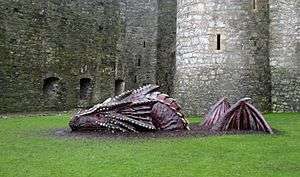
While generally escaping extreme weather, it should not be forgotten that the British Isles enjoy a famously changeable climate and few places more so than Wales. As such, it is extremely important to be prepared when venturing into the countryside and especially onto the mountains. Here, what starts as a sunny day can rapidly turn into a blizzard, storm-force gale or a disorienting, chilling fog. Every year, many have to be rescued from Snowdonia and the Brecon Beacons and some lives are lost due to falls and exposure. Ensure you have suitable clothing, a map and a fully-charged mobile phone before setting off.
On the coast, tides can cut you off on rapidly disappearing sea-level land. On the cliff tops be aware that the land can overhang the cliff edge being very thin and unstable.
There is little danger from animals, with only a small chance of coming across the adder snake which is venomous. Bites are painful but rarely fatal; stay calm but get to a doctor if bitten. The most dangerous animals are cattle and the occasional aggressive sheep. It is very rare to come across a live dragon.
Respect
Welsh society is generally warm, informal and welcoming, with a tradition of acceptance and tolerance (for instance, there is no history of support for racist political parties in Wales's larger cities). There is little risk of causing any offence unless you stray into the vexed issue of the difference between Wales and England.
The crucial point is that there is a difference: Wales is emphatically not part of England. Referring to Welsh people as English will cause annoyance: it is such a crass error that people may well think you are trying to start an argument. The relationship between England and Wales is long, complex and sometimes controversial. The geopolitical ties between England and Wales are strong, though some light-hearted anti-English sentiment is common, particularly in the patriotic North West of the country. Despite this, English people in Wales are unlikely to face any issues. For instance, the rivalry between the Welsh and English rugby teams is fierce and long-standing, but fans of both sides mingle freely and happily during and after matches.
Criticisms or jokes about the Welsh language are also deeply offensive to people whose first language is Welsh, and often to other Welsh people too. The Welsh language is an extremely important part of national culture and identity, and even Welsh people who only otherwise speak English know all the words to Hen Wlad Fy Nhadau, the national anthem.
In some areas there are high levels of support for independence, which isn't universally shared. It is best to steer clear of this topic, if you want to avoid getting into a long debate.
Wales is much like the rest of the UK regarding attitudes towards homosexuality. Displays of homosexuality are not always commonplace, possibly due to the rural nature of some parts of the country, although outward displays of same-sex affection are unlikely to cause a problem. Larger towns and cities are also friendly and open minded, but issues are not unheard of.
Connect

See Connect entry in our United Kingdom article for information on telephone, internet and postal services. Some rural areas do not have mobile phone reception and few areas, including towns have high-speed internet.
See Connect entries in individual city articles for local information.
Go next
- To the east the English border counties of Gloucestershire, Herefordshire and Shropshire are a quiet, almost undiscovered area, before you move in to the higher population areas of the West Midlands and Merseyside. Or if you are looking for the quintessential England try the Cotswolds.
- Ireland, if you have not had enough of beautiful wet green landscapes then this the direction to go. Reachable by ferry from a number of places on the west coast.
